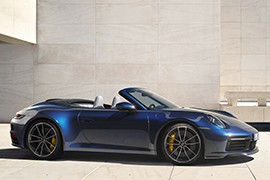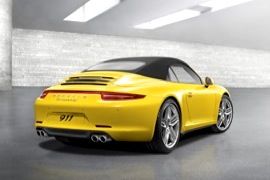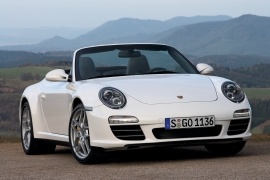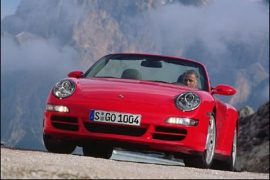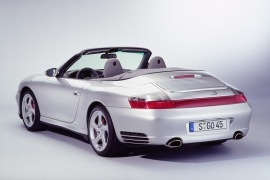PORSCHE 911 Carrera 4S Cabriolet Models/Series Timeline, Specifications & Photos
First production year: 2003
Engines: Gasoline
Body style: Convertible (spider/spyder, cabrio/cabriolet, drop/open/soft top)
The 992 generation of the famous Porsche 911 was unveiled in 2018 at the Los Angeles Auto Show. Only six weeks later, the open-top Carrera 4S was introduced to the market.
There was a long history for the powerful, convertible, Porsche 911. The Carrera 4S featured a mix of parts from the Turbo model and the lower specs Carrera. The final touch to the mix was the Carrera 4S Cabriolet, that combined performance and the roadster sensation offered by the open-top vehicle.
The new Carrera 4S 992 generation was wider by 45 mm (1.77”) on the front and with 44 mm (1.73”) on the rear than the generation it replaced. The standard headlights were with full LEDs. The front end resembled a traditional feature from earlier 911 generations: a forward-extended hood with a distinctive recess in front of the windscreen.
The interior was reworked and featured two LCDs inside the instrument cluster, flanking the classical tachometer, which was analog. Also, on the center console, there was a 10.9-inch display used for the PCM (Porsche Communication Management) that supported Apple CarPlay but not Android Auto. The system also featured an online navigation system, with real-time data for the traffic ahead. To open or close the car, a new soft top and mechanism were installed. It could do the process in just 12 seconds at speeds up to 50 kph (31 mph)
The engine was a flat-six cylinder with twin-turbochargers. The total output is higher with 30 HP than the previous generation, reaching 450 HP. It was mated to a standard 7-speed manual or a 7-speed PDK (dual-clutch) automatic. The PASM (Porsche Active Suspension Management) system was standard.
The 2012 Porsche Carrera 4S Cabriolet was that daily-driver supercar that could take its top off in 13 seconds and run away with its 400 hp delivered to its all-wheel-drive system. It took it, in total, less than 20 seconds to get in, start, uncover and reach 100 kph (62 mph).
Porsche always had open-top vehicles. Looking back, it had a glorious roadster over the years. Some of them were meant for racing and performance. But there was a switch toward the luxurious convertibles, with high-performance and able to be used as a daily driver car.
The 2012 Carrera 4S Cabriolet had the same wider rear track when compared to the non-S version of the vehicle. It wasn't something everyone would notice, but the difference was there for a reason, and that reason was the wider tires installed. From behind, a rear red light-strip united the LED taillights.
Inside the Carrera 4S Cabriolet, there were some luxury features. The leather-covered sport-bucket seats were covered in leather. Even the rear, unusable, seats were wrapped in leather. The center console was higher to give the driver a sense of a single-seat racing roadster. On the console, there were the buttons for adaptive suspension and other technical features of the vehicle plus the gearshift lever. Porsche offered a 7-speed manual as standard or a 7-speed dual-clutch PDK system for the transmission. The 7-speed manual had an interesting feature that prevents the driver to accidentally downshift from 7th to 4th, which could damage the engine.
In 2004, Porsche launched a new generation of its well-known Porsche 911.
That generation was named 997 and it represented an important upgrade for the whole range, especially after the 2008 facelift.
After four years into production, a mid-life cycle refresh was ready for the market. Porsche had to improve its engines to make them cleaner and to respect the new pollution norms in Europe. It meant that it had to build its cars more fuel-efficient. As usual, the rest of the car suffered some minor changes too.
On the outside, the first difference was on the front bumper, where larger air-intakes were sculptured. The headlights were fitted with LED daytime running lights and an option for bi-xenon lamps was added to the list. The rearview mirrors were slightly redesigned. A new set of 19” light-alloy wheels was introduced for the Carrera 4S. As usual, both versions 4 and 4S Cabriolet featured wider rear fenders. In the rear, the taillights received an LED design. For the 4S, a reflective strip was placed between the taillights.
As any premium or sports convertible, the Carrera 4 and 4S cabriolet featured a power-roof, which could cover and uncover the car in 20 seconds. The interior featured a new PCM (Porsche Communication Management), which supported the Apple CarPlay. For Android users, there was an app to download, but it didn't work as well as the iOS systems.
The Carrera 4 Cabriolet featured a 3.6-liter engine that cranked up 325 hp, while the 4S version offered 355 hp from a 3.8-liter. Both versions were mated as standard to a 6-speed manual and a 7-speed automatic PDK (dual-clutch) was on the options list.
Along with its sibling Carrera 4, the 2005 Carrera 4S offered an all-wheel-drive system for the Porsche 911, but as usual, it was more powerful.
The 997 Carrera 4S and the Carrera 4S Convertible were developed at the same time. That led to a small weight difference between the two vehicles. The convertible was only 85 kilograms (180 lbs) heavier than the coupe, which made it as fast as the closed-version. The 4S Convertible was based on the same platform with its predecessor but enhanced. Its wider body by 88 mm (3.5”) than its two-wheel-drive sibling, made it look meaner. It offered an enhanced all-wheel-drive system, which transferred between 5 and 40% of the torque to the front wheels.
From the outside, the new round headlights were back, wiping off the tears from the Porsche fans. The turn-signals and the fog-lights were in the front bumper, above the apron. In the lower side, a wide center grille and two side-scoops with a horizontal slat were typical for this generation of the Porsche 911. In the back, the Carrera 4S featured four round exhausts under the rear apron.
Inside, the Carrera 4S Cabriolet offered four seats but cramped in the rear. It featured the same options as the coupe, plus the wind deflector. That allowed a normal conversation even with the top down at highway speed. To cover or uncover the car, the electric system needed only 20 seconds at speeds up to 50 kph (31 mph).
For the engine, the Carrera 4 S featured a 3.8-liter unit that offered 355 hp. On the options list, the car-maker introduced the X51 feature, which increased the power to 381 hp. Regardless of the power, the flat-six engine was mated as standard to a 6-speed manual, while a 5-speed automatic with manual override (Tiptronic) was on the options list.
In 2002, the entire generation of the Porsche 911 – 996 was facelifted. The Carrera 4S Cabriolet was introduced in the lineup with the new engine and the Turbo bodywork.
There were not too many all-wheel-drive convertibles in 2002, and for sure there were only a few that could boast up to 320 hp. The Carrera 4S, introduced for the first time in 2002, was launched to fill the gap between the regular Carrera 4 and the Turbo.
From the outside, the Carrera 4 S Cabriolet featured the same front bumper as the Turbo. The rear wide fenders looked almost the same, except the side air-intakes, which were not needed. The sloped back of the car was fitted with the same self-adjusting spoiler, that could deploy or retract depending on the speed. The three-layer canvas-top was powered and it needed 20 seconds to completely retract or cover the car, at speeds up to 50 kph (31 mph). For winter, the car featured an aluminum hard-top.
Inside, the car featured full power-adjustable leather seats for the driver and passenger (with driver's side memory). The seat's position was related to the key used to open the car so, if two drivers would use the vehicle, at the opening the door mirrors and the seat was adjusted accordingly. A new infotainment unit (Porsche Communication Management) was installed, with an option for sat-nav.
The drivetrain received a new 3.6-liter engine and it gained 20 hp more than the non-facelifted version. It was fitted with a standard 6-speed manual. The 5-speed automatic (Tiptronic) gearbox with manual override to change gears was on the options list. Due to its all-wheel-drive system, it could cope better with the bad weather than most of the sports-cars from that era.
